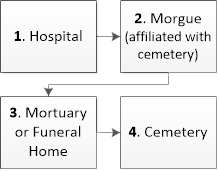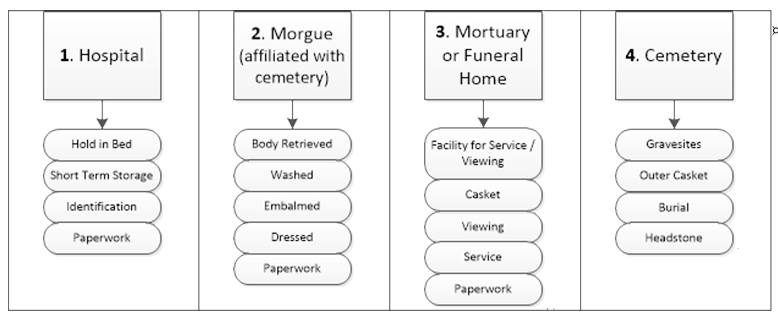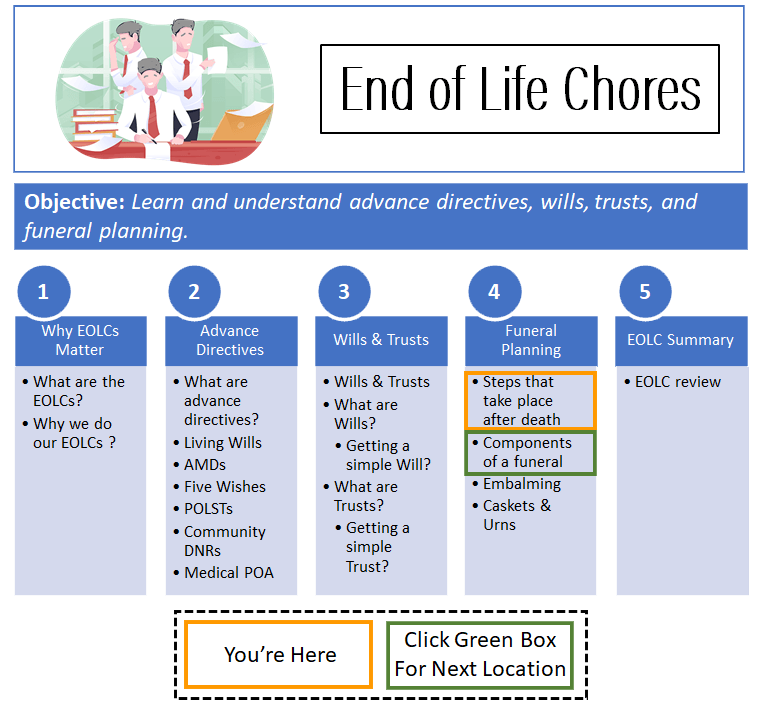What Happens After Someone Dies In A Hospital?
Click here to see what's on this page.
If you haven’t been present through an entire end-of-life cycle, you may not know what happens after someone dies in a hospital or hospice. To illustrate, Carmen and I will walk through you the most common steps that occur after a death. For example, we’ll presume the death occurs in a hospital.

After death, a number of organizations are involved. For example, mortuaries, funeral homes, and cemeteries are likely to perform tasks.
Organizations That Manage The Body
The basic entities that manage the body are the hospital, a mortuary, a funeral home, and a cemetery. Last century, many of the activities were done by specific organizations. Funeral homes sold caskets and held services. Mortuaries prepared bodies, and cemeteries sold burial plots and laid people to rest. Today, a “Funeral Home,” “Cemetery,” or “Mortuary” is often part of a larger organization or affiliated with one and may provide multiple services (i.e., mortuary and cemetery).
Managing The Body
Once your loved one passes, the body must be managed. State and other government regulators have rules that dictate the process. There are also rules about the physical body that include how to store or prepare a body (refrigeration, embalming, cremation), the length of time that a body can be stored in a condition before embalming or refrigeration must take place, and requirements to transport a body over distances (generally a body must be embalmed to transport across state lines). There are paperwork issues that include identification of the body, cause of death and death certificates. And there are disclosure issues involving sales that include things like pricing, cemetery land ownership, and the ability to purchase things like caskets from third parties.
Some activities/tasks include:

Click on the links below to become familiar with what happens at the hospital, mortuary, and cemetery.
Step 1 – Initial Body Management
After someone dies in a hospital they will generally briefly hold the body for visitation, store the body (if they have an onsite morgue) for up to 48 hours, identify the deceased, and start death paperwork. The same is true for deaths in hospice. Although most hospices do not have onsite storage facilities. More here.
Step 2 – Body Transport & Prep
After death, the hospital or hospice will notify a mortuary crematorium of the passing. Consequently, they will retrieve the body. Mortuaries and crematoriums perform their tasks. These also include preparing the body, completing death paperwork, and ordering the death certificates. More here.
Step 3 – Viewing(s)
Many religious traditions involve viewing the body. Funeral homes and mortuaries, for example, offer these services. More here.
Step 4 – Burials & Cremations
Cemeteries bury bodies. Crematoriums cremate bodies. They also prepare bodies. More here.
Other Resources On What Happens After Someone Dies In A Hospital
A good article from the National Institute on Aging here.
Also, a good article here.
